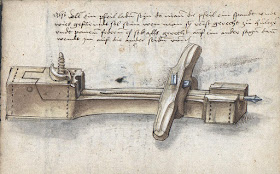
Martin Löffelholz was a master technician born around 1496 in Nürnberg, Germany. Like his famous contemporary city member Albrecht Dürer he was also a bit of an inventor. In 1505 he wrote a book - the Löffelholz codex - containing technical examples of tools, furniture, machines of war (e.g. crossbows) and 'interrogation' equipment. Most famous is his workbench containing one of the first screw-vices. Martin Löffelholz became alderman of Nuremberg in 1528 and passed away on 28 April. 1533. The Löffelholz Codex now resides in the Jagiellonian Library in Krakow, Poland, but the contents can be viewed online. (The only problem is that the official site hosting the codex is very unstable and crashes after viewing a few pages. The codex can also be downloaded, but you then need a special graphics program - Djview - to view/convert the .djvu files.)

A workbench with a double screw vise as well as an end-vise. The end-vise clamps wooden stock against an iron dog. Several holes have been provided for the iron dog, which can also be sunken level to the workbench top.With the two vises the workbench looks very like the modern workbenches.

A similar workbench but with different pointed dogs.

The parts and construction of the end-vise of the second workbench, together with the pointed dog.

A double screw vise; here used as a paper press. More on medieval double screw-vises can be found in this blog post.
The Codex Löffelholz, however, contains much more ingenious tools, including those needed to make the wooden screws and screw-nuts.

On the left page the auger to tap the screw-nut is shown. Note that this auger can produce holes of three different sizes! Mine, only can do one size... On the right page the threadbox, both open and closed. Compare these tools with the modern versions on the photos shown below.


Left: The opened modern threadbox. Right: the nut-auger.


Left: the Loffelholz brace with several spoon bits. Right: a 19th century Sheffield brace with a set of bits.


Left: a tapered reamer used for enlarging holes or making tapered mortises. This tools is e.g. used by cart-wrights and coopers. Right: an antique coopers bung hole reamer. Note that both augers start with a twisted part.


Left: A wooden leg vise with metal clamps. Right: a modern antique full metal version.




One wooden divider and three metal ones. Interestingly, to become a master compassmaker in the Nuremberger guild the apprentice had to make such a metal compass with screw. Several of these items could also be found in the Germanisches Nationalmuseum in Nuremberg, which I visited this summer.
To become a master compass-maker in Nuremberg around 1600, the apprentice had to make a handheld vise, a thumbscrew compass, pincers and an all purpose hammer. At least one complete set was always kept in the guild chest.


Left: An auger as an adjustable circle cutter. Right: The modern version of it.

A triple auger drill; the handles are augers themselves.

A machine to make crossbow arrows. The wooden shaft is clamped by a screw-vise, while a spokeshave/scraper/plane like tool moves along a fixed track to smooth the arrow shaft.

A close up of the scraper tool.
The Löffelholz Codex also contains some furniture pieces, among those a rocking cradle and an office chair.


Two drawings of a rocking cradle. These kind of cradles are ubiquitously depicted in late medieval manuscripts
showing the birth of Maria.

The right upper part of the Maria altar showing a similar cradle painted by Marx Reichlich (around 1500).
Alten Pinakothek Muchen, Germany.


The first office chair on wheels?


Another fascinating post, thank you Marijn. I was particularly impressed with the tools made by the compass maker apprentice. How did they make those intricate and complex components without tools that we take for granted, such as an electric-powered engineering lathe? Incredible skill.
ReplyDeleteThis comment has been removed by a blog administrator.
ReplyDeleteIs there an english translation of this available?
ReplyDeleteI don't think so, at least not for the complete notebook. Christopher Schwartz (lost art press) has been involved in the translation some parts that relate to the workbench.
ReplyDeleteThank you for a very interesting post. What is the original language of the book?
ReplyDeletemedieval German language handwriting. Not easy to decipher.
DeleteI am assuming he did not actually write the book at the age of 9, and one of the two dates (1496 or 1505) is incorrect?
ReplyDeleteA good point, the age of 9 is indeed a bit early to write and draw these images. As 1505 is on the book (see first image) the birth date is most likely wrong.
DeleteGo to files section and download the .pdf
ReplyDeleteFascinating thank you
This is absolutely fascinating. Was this a book detailing extant technology, like Moxon, or concepts, like Da Vinci's flying machines? I haven't seen, for example, much on 16th century metal screws, but he has them all over these pages.
ReplyDelete